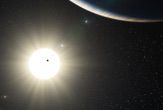Alien Solar System Looks Strikingly Like Ours

Astronomers have discovered a group of at least five planets — with hints of two more — circling around a star in an arrangement similar to our own solar system. Confirmation of the extra planets would make this the highest tally of alien worlds ever spotted around a single star.
The planets and their own sun-like star are about 127 light-years from Earth, astronomers with the European Southern Observatory said. It is one of just 15 planetary systems known to have more than three worlds.
The five planets circle their parent star, HD 10180, in a regular pattern like the planets of our solar system, only in a more compact arrangement, the researchers said.
Of the two potential additional planets that may be present, one may have a mass that is the closest to the Earth's yet seen, if it is confirmed, they added. [ The Strangest Alien Planets ]
"We have found what is most likely the system with the most planets yet discovered," astronomer Christophe Lovis, lead author of the study, said in a statement Tuesday. "This remarkable discovery also highlights the fact that we are now entering a new era in exoplanet research: the study of complex planetary systems and not just of individual planets.
"Studies of planetary motions in the new system reveal complex gravitational interactions between the planets and give us insights into the long-term evolution of the system."
The research was announced at an international colloquium on extrasolar planets at the Observatoire de Haute-Provence, France. It came just days ahead of a scheduled announcement from NASA's Kepler planet-hunting mission to discuss an "intriguing planetary system."
Sign up for the Live Science daily newsletter now
Get the world’s most fascinating discoveries delivered straight to your inbox.
Lovis and his team used the planet-hunting HARPS spectrograph instrument on a 3.6-meter telescope at the European Southern Observatory in La Silla, Chile, to detect the system in the constellation Hydrus.
The instrument allows astronomers to measure the movement, or "wobble," of a star caused by the gravitational pull of planets orbiting around it.
The five strongest wobble signals were caused by planets with masses similar to Neptune, between 13 and 25 times the mass of the Earth.
Though these planets are relatively large, they are located close to their parent star and race around at intervals that range from just six days to 600 days.
The closest planet is not quite 5.6 million miles (9 million km) from HD 10180, compared to the 93 million miles (150 million km) separating Earth from the sun, a distance also known as an astronomical unit. The distance of the farthest one from its star is about 1.4 AU.
When compared to our solar system, all of these planets would fit inside the orbit of Mars and appear to have nearly circular orbits.
The wobble method for detecting alien planets also suggested more worlds are orbiting HD 10180, one of them up close and the other far off.
We also have good reasons to believe that two other planets are present," Lovis said.
One of these extra planets, if confirmed, would be much like Saturn, with at least 65 times the mass of Earth and year that lasts 2,200 days.
The other potential planet is the most tantalizing for astronomers. If confirmed, it would be the least massive world ever found outside our solar system, with a mass just 1.4 times that of Earth. It is thought to orbit extremely close to the star — just 2 percent of an AU — and completes its circuit in only 1.18 Earth days, researchers said.
"This object causes a wobble of its star of only about 3 km/hour — slower than walking speed — and this motion is very hard to measure," said study team member Damien Segransan.
This planet would probably be a small, rocky world similar to the hellish planet Corot-7b, which orbits close to a different star. There the daytime temperatures can reach 4,000 degrees Fahrenheit (2,200 degrees Celsius), with nighttime lows of minus 350 F (minus 210 C).
The newly found system could set the extrasolar record for most known planets. It currently shares the record with the system around the star 55 Cancri, which has five planets, two of them gas giants.
No gas giants seem to be present in the HD 10180 star system.
"Systems of low-mass planets like the one around HD 10180 appear to be quite common, but their formation history remains a puzzle," Lovis said.

Tariq is the editor-in-chief of Live Science's sister site Space.com. He joined the team in 2001 as a staff writer, and later editor, focusing on human spaceflight, exploration and space science. Before joining Space.com, Tariq was a staff reporter for The Los Angeles Times, covering education and city beats in La Habra, Fullerton and Huntington Beach. He is also an Eagle Scout (yes, he has the Space Exploration merit badge) and went to Space Camp four times. He has journalism degrees from the University of Southern California and New York University.












